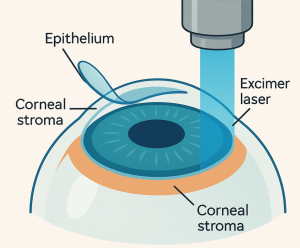PRK is commonly known as “LASIK without a flap.”
Photorefractive Keratectomy (PRK) is a type of laser correction surgery that it used to treat myopia (nearsightedness), hyperopia (farsightedness), and astigmatism.
Although both procedures work to reshape the cornea in order to treat vision problems, PRK differs from LASIK in that it doesn’t require the surgeon to create a corneal flap. The procedure treats the surface of the eye without necessitating a flap by first gently scrubbing the top layer of the cornea, called the epithelium. It then uses a laser to reshape the cornea, just like in LASIK eye surgery. PRK has been associated with a slightly higher level of discomfort than LASIK eye surgery.
 Based on the results of your pre-operative, comprehensive eye exam, you may be recommended for PRK instead of LASIK. There are several reasons why your eye surgeon may recommend PRK over LASIK or another vision correction procedure. PRK is generally recommended to individuals with thinner-than-average corneas. This is because there’s not enough corneal thickness to create the flap necessary in LASIK. Similarly, it will be recommended to individuals with soft corneas, as these have a greater chance of bending out of shape and are thus not suitable for the creation of a corneal flap. Finally, PRK may also be recommended to people with vocational or sports-related limitations where creating a corneal flap would not be recommended.
Based on the results of your pre-operative, comprehensive eye exam, you may be recommended for PRK instead of LASIK. There are several reasons why your eye surgeon may recommend PRK over LASIK or another vision correction procedure. PRK is generally recommended to individuals with thinner-than-average corneas. This is because there’s not enough corneal thickness to create the flap necessary in LASIK. Similarly, it will be recommended to individuals with soft corneas, as these have a greater chance of bending out of shape and are thus not suitable for the creation of a corneal flap. Finally, PRK may also be recommended to people with vocational or sports-related limitations where creating a corneal flap would not be recommended.